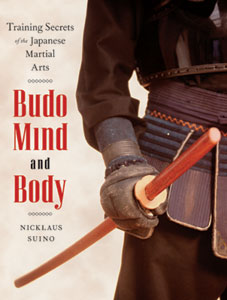|
|
Nicklaus Suino and Shambhala Books Presents

Budo Mind and Body: Training Secrets of the Japanese Martial Arts
by Nicklaus Suino
Boston: Weatherhill
2006, 160 pp., 5.5" x 7.25" illus. (hardcover)
ISBN 0834805685 . $16.95
Available from:
Shambhala Publications
P.O. Box 308 Back Bay Annex
Boston, MA 02117-0308
Toll-free Tel: 888.424.2329
Tel: 866.424.0030
Fax: 617.236.1563
E-mail: custserv@shambhala.com
www.shambhala.com
Review by John Donohue, Ph.D.
Albertus Magnus College
Nicklaus Suino has established himself as an authoritative writer about and
practitioner of the Japanese martial tradition. He writes balanced, thoughtful
works on budo, and this latest work is no exception.
Budo Mind and Body is, in fact, a modified version of his 1996 work Arts of
Strength, Arts of Serenity. The current book contains five short chapters:
Training the Body, Training the Mind, Budo Culture, Three Martial Virtues, and
Training the Spirit. In these short sections, Suino provides cogent, down to
earth analyses of the process of walking the martial path in Japan's modern
arts. Despite the breathless editorial subtitle that hints at "training
secrets," Suino does a nice job of expressing how the study of budo is a
process requiring discipline, patience, and effort. The results can be profound
and transformative, as Suino clearly believes, but his conviction that these
results are achieved through rigorous training comes as a nice corrective to
popular ideas about the martial arts and magical skill.
The author includes nice thumbnail sketches of various modern martial arts as an
aid to individuals considering taking up the study of one or the other. This
book is, in fact, a nice introduction to budo for individuals new to the world
of the dojo. It is short on hyperbole and long on experience and common sense.
I would recommend it as an appropriate work for novice students, although the
clarity of Suino's prose and the sincerity of his convictions regarding the
benefits of studying budo would recommend it to any reader who shares something
of his experience and his beliefs.
Suino also provides a brief bibliography at the close of the book. While
composed of the author's personal favorites, the list would have benefited from
the inclusion of some additional resources.there are, for example, newer and
more accomplished introductory works on kendo than Sasamori and Warner's
forty-year old book, and the reading public has benefited from quality work on
kyudo by the Deprosperos.
As a final quibble, while I congratulate Weatherhill on the firm's continuing
success in producing quality works on martial subjects, I do wish that they
would consult with people (like their own authors) before designing jacket
covers. Suino's fine book is fronted by a photograph of an individual wearing
full kendo armor, grasping a wooden sword. Trainees in kendo use the bokken,
but don't do so wearing the protective mitts known as kote. And even the
greenest beginner in any of the sword arts could have told the photographer
that the practice sword is held with the cutting-edge up. These kinds of errors
probably make an accomplished individual like Suino grind his teeth in
frustration, but he should rest assured that, whatever the minor flaws of the
book's cover, the contents are of high quality.
Available at fine bookstores everywhere, and at Shambhala Books
and Amazon. Signed copies
will be available directly from the author. Send your request to Suino Sensei
at info@artofjapaneseswordsmanship.com
|